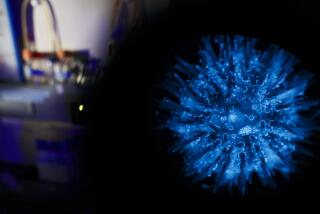No Embryos Lost to New Stem Cells
- Share via
Scientists say they have created viable embryonic stem cell lines without destroying any embryos -- a development that could clear ethical barriers that have sharply restricted federal funding for the controversial research.
Two separate techniques were demonstrated in mice, and researchers are optimistic the processes could be replicated with human cells. The new methods were published online Sunday by the journal Nature.
Scientists and ethicists said the approaches offered a potential compromise with social conservatives who see embryonic stem cell research as an untenable trade-off that amounts to destroying life to create medical cures.
Dr. William B. Hurlbut, a member of the President’s Council on Bioethics, said he had persuaded several religious and conservative philosophers that at least one of the new approaches was morally sound.
But given the intractable debate about when life begins, there are lingering ethical concerns.
Neither method “really quells the ethical debate,” said Dr. George Q. Daley, a professor of biological chemistry and molecular pharmacology at Harvard Medical School. “It’s not clear it’s going to answer all the critics.”
Protection of human embryos has been the guiding principle behind President Bush’s stem cell funding policy.
Bush was the first to approve federal money for the research, but he limited funding to the cell lines already in existence in 2001 to avoid having taxpayers subsidize the destruction of embryos. Scientists have said that only about 20 of them were usable.
Those lines, which have proven unsuitable for some research, were derived from frozen embryos donated by couples that no longer needed them for in vitro fertilization.
The federal restrictions have hampered scientists seeking to tap the therapeutic potential of embryonic stem cells, which have the capacity to grow into any cell type in the human body. Researchers believe, for example, that the cells might eventually be used to treat juvenile diabetes by growing replacements for faulty islet cells that make insulin.
Some researchers have moved forward by using private funds to create their own lines of embryonic stem cells. California has taken the most aggressive position, passing Proposition 71 in 2004 to provide $3 billion for stem cell research.
One of the new approaches reported in Nature is based on a routine procedure used by fertility clinics to look for genetic defects in embryos.
Dr. Robert Lanza, medical director of Advanced Cell Technology Inc. in Worcester, Mass., and an author of one of the papers, extracted a single cell from a mouse embryo that developed in the laboratory into an eight-cell bundle.
After removing the cell, called a blastomere, Lanza’s team surrounded it with human embryonic stem cells from the Bush-approved lines, allowing the mouse cell to pick up the appropriate biochemical cues to start behaving like a stem cell.
Using 125 blastomeres, they were able to create five cell lines that tests found had the same properties as embryonic stem cells.
To demonstrate that the single-cell biopsy posed minimal risk to the embryo, seven-cell mouse embryos were implanted into surrogate mothers. They resulted in live births 49% of the time, virtually the same as for the regular eight-cell embryos.
Lanza said human stem cell lines could be created using single cells extracted for genetic diagnosis at in vitro fertilization clinics.
In a laboratory dish, the extracted cell would be allowed to divide into two. One cell could be screened for genetic defects and the other used to create stem cells, he said.
“It’s relatively simple,” Lanza said. “It does not damage the embryo, and it’s been used on thousands of healthy babies.”
The other approach, developed by MIT biologist Rudolph Jaenisch, relies on deactivating a gene needed to implant an embryo into a uterus.
Jaenisch altered mouse DNA and inserted it into an egg whose own DNA had been removed using a common stem cell procedure called nuclear transfer.
Because the resulting embryo could not attach to the uterus, it would have no chance to develop into a healthy baby, thus presumably avoiding any ethical quandary. Hurlbut, the presidential advisor, strongly backs this approach.
After the DNA insertion, the egg was prompted to begin developing and stem cells were harvested a few days later.
To complete the experiment, the researchers turned the silenced gene back on. The resulting stem cells demonstrated the same abilities as traditional embryonic stem cells.
Scientists say this approach is attractive because it offers the ability to tailor stem cells to specific patients.
Although the process is cumbersome, scientists would probably be willing to do it to qualify for federal funding, Jaenisch said.
But both methods still present some ethical hurdles.
Some scientists believe that a single human blastomere may be able to develop into an embryo, throwing Lanza’s method into the same ethical terrain as conventional stem cell methods, said Daley, the Harvard professor.
He said that Jaenisch’s method seemed like no more than a cosmetic solution.
“A process that dooms an otherwise normal embryo to later demise” may not “answer all the critics,” Daley said.
Dr. Irving L. Weissman, the director of Stanford University’s stem cell institute who wrote a commentary accompanying the Nature papers, said the new methods amounted to “a diversion of good science by politics,” but that the trade-off would be worth it if it would speed the delivery of therapies to patients.
Hurlbut, the member of Bush’s bioethics panel, said the new research might at least spark a debate about what would make embryonic stem cells ethically palatable to all Americans.
“We need an answer,” he said.







